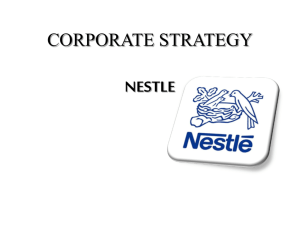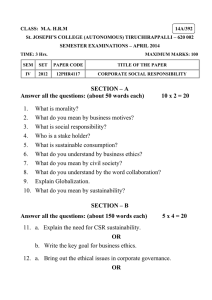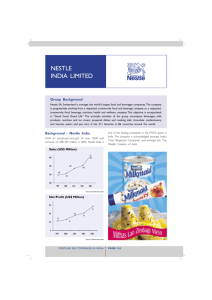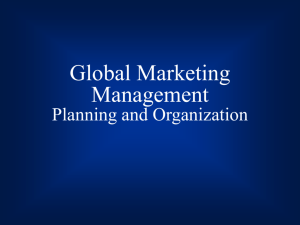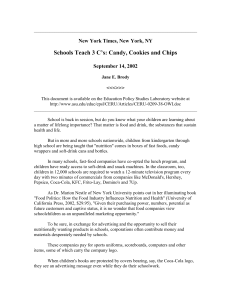File
advertisement
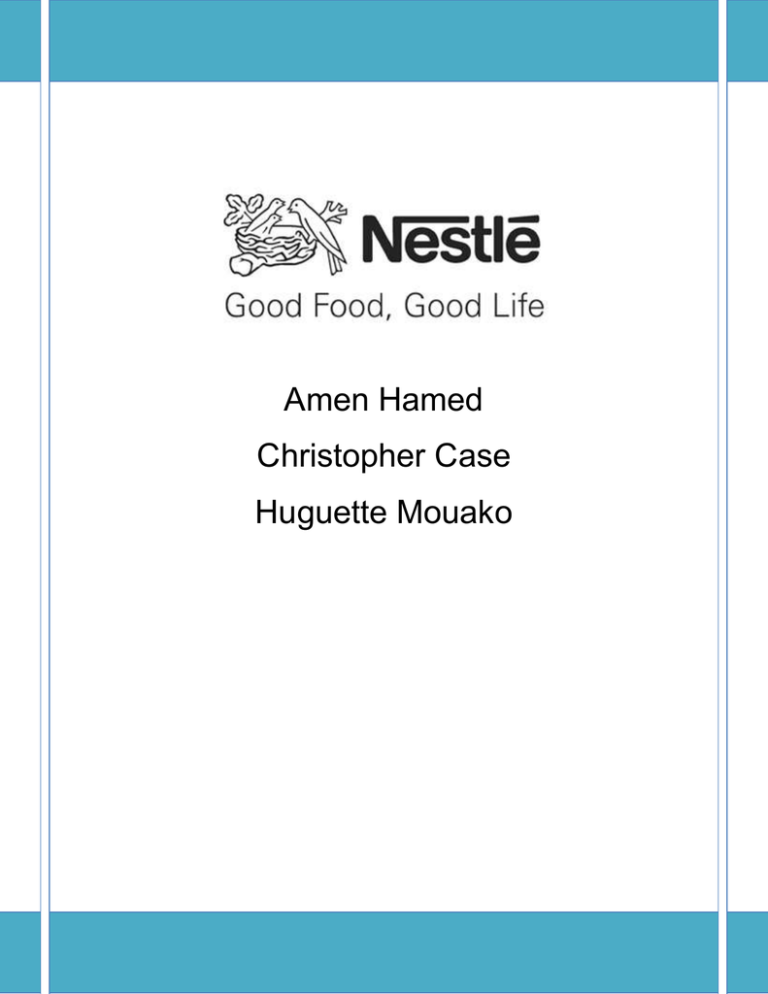
Amen Hamed Christopher Case Huguette Mouako Table of Contents Company Overview .......................................................... 2 Company Mission and Vision ........................................... 2 Company Structure .......................................................... 2 Supply Chain ..................................................................... 3 Customer .......................................................................... 6 Challenges ........................................................................ 6 Order Processing .............................................................. 7 Customer Service Metrics ................................................ 9 Procurement...................................................................10 Responsible Sourcing Activities at Nestle ..................... 12 Supplier Information ...................................................... 13 Inventory ........................................................................14 Manufacturing or Process .............................................. 14 Competition ....................................................................15 Logistics Facilities Network ............................................16 Transportation Methods ................................................ 16 Uniqueness .....................................................................17 Mission/Vision................................................................ 18 Works Cited ....................................................................19 Page 1 of 20 Page 2 of 20 COMPANY OVERVIEW Nestlé is a Swiss multinational food and beverage company headquartered in Vevey, Switzerland. It is the largest food company in the world measured by revenues. Nestlé’s products include baby food, bottled water, breakfast cereals, coffee and tea, confectionery, dairy products, ice cream, frozen food, pet foods, and snacks. Twentynine of Nestlé’s brands have annual sales of over $1.1 billion, including Nespresso, Nescafé, Kit Kat, Smarties, Nesquik, Stouffer’s, Vittel, and Maggi. Nestlé has 447 factories, operates in 194 countries, and employs around 333,000 people. It is one of the main shareholders of L’Oreal, the world’s largest cosmetics company. Nestlé was formed in 1905 by the merger of the Anglo-Swiss Milk Company, established in 1866 by brothers George Page and Charles Page, and Farine Lactée Henri Nestlé, founded in 1866 by Henri Nestlé. The company grew significantly during the First World War and again following the Second World War, expanding its offerings beyond its early condensed milk and infant formula products. COMPANY MISSION AND VISION Nestlé’s “mission of 'Good Food, Good Life' is to provide consumers with the best tasting, most nutritious choices in a wide range of food and beverage categories and eating occasions, from morning to night.” The company doesn’t mention any values, which guides its actions, in the statement but provides them in addition to their vision: “To be a leading, competitive, Nutrition, Health and Wellness Company delivering improved shareholder value by being a preferred corporate citizen, preferred employer, preferred supplier selling preferred products.” COMPANY STRUCTURE Nestlé has a Board of Directors, led by Chairman Peter Brabeck-Letmathe, who was the former Nestlé CEO. There are 14 members of the Board of Directors. The dayto-day management of the Nestlé business is taken care of by the Executive Board. The 14 designated Board Members manage diverse parts of the global business. The Nestlé Page 3 of 20 Group is managed by geographies - Zones EMENA (Europe, Middle East and North Africa), Americas and Asia/Oceania/Africa - for most of the food and beverage business, with the exceptions of globally managed businesses, which include Nestlé Waters, Nestlé Nutrition, Nespresso, Nestlé Professional and Nestlé Health Science. They also have joint ventures such as Cereal Partners Worldwide and Beverage Partners Worldwide. Nestle products are sold in every country except North Korea, this indicative of the company’s global reach. Nestlé has five operating divisions. The food businesses operate as three geographic divisions in the Americas, Europe and Asia Pacific regions, while the company's water and pharmaceuticals businesses operate as separate global units. The group's products fall into six categories. However across these, there are six main brands which between them generate more than 70% of group revenues. The biggest of all is the main Nestlé brand, used across dairy products, mineral water, confectionery and prepared foods. SUPPLY CHAIN Nestle was recognized for holding their suppliers accountable to a “nodeforestation” policy on palm oil. Nestle along with PepsiCo also “bundled their warehousing, co-packaging and outbound distribution of fresh food products leading to logistics, cost savings, service level improvements and carbon reductions.” Nestle also employs traceability requirements for its suppliers, who must report on their supply chain, specifically the origin of products provided to Nestle, so the company has a comprehensive picture from farm to consumer. Nestlé operates within complex supply chains. Its cocoa supply chain goes from cocoa bean to chocolate bar. This path starts with cocoa from farmers, who grow the crops; to cooperatives, which manage the sale of the crops; to processors and manufacturers, such as Nestlé which create chocolate products; to retailers such as supermarkets, and finally to consumers who purchase the products. Nestlé sources materials from thousands of farms, many of them small farmers in poorer rural regions of the world. In many rural communities, a lack of investment in infrastructure has a Page 4 of 20 serious impact on the quality and quantity of raw materials that Nestlé and other companies rely on. Nestlé provides training in order to encourage sustainable production, protect the supply and quality of its raw materials and have a positive, longterm impact on the local economy and farmers’ standards of living. For Nescafe products, Nestle Bangladesh collects raw material from Nestle Malaysia. Nestle Bangladesh imports coffee in bulk where, each container contains 25 kg of grinded coffee as raw material. They also import finished Nescafe products like the Nescafe Classic Jar and Nescafe 200 gm pillow pouch directly from Nestle Malaysia. The main reason for collecting from Malaysia is that the cost is relatively low. Page 5 of 20 Primary Supply Chain Processes of Nescafe Packaging and Processing Secondary Supply Chain Page 6 of 20 CUSTOMER Consumer interest in the nutritional quality and health impact of foods has probably never been greater and for good reason. Governments have been busy spreading the message that healthy foods and a balanced diet are vital for good physical and mental health and a general feeling of wellness. Nestlé is one of the world's leading food companies and intends to remain so. Its commitment to high quality market research ensures that it remains fully aware of changes in consumer behavior and consumer tastes. Its excellent product research and development network ensures that it is well placed to meet the challenge of changes in consumer expectations. The company's wellness strategy is carefully geared to delivering to customers what they now clearly want in relation to the foods they eat; a high nutritional value and a positive contribution to their general wellness. CHALLENGES Supply chain knowledge is becoming more and more critical to ensure competitive supplies of goods and services, especially for large companies dealing with a complex network of suppliers, customers, distributors and consumers. All parties in the chain need to have a particularly good grasp of how their individual activities work together and affect the performance of the whole supply chain. At Nestlé, Key Performance Indicators (KPIs) provide the standard metrics for measuring supply chain performance. Nestlé launched a new initiative to communicate the value and use of KPIs to line managers. As a major buyer Nestlé seeks to be as closely involved in the supply chain as possible, to ensure quality and fairness. Currently Nestlé is participating in a process to examine potential problems of forced child labor on cocoa farms in West Africa. This is being done on an industry wide basis, in consultation with governments, labor organizations and Non-Governmental Organizations (NGO), as well as with other members of the cocoa and chocolate industry. Page 7 of 20 The Nestlé Cocoa Plan is a $120-million initiative to improve cocoa sustainability and the livelihoods of cocoa farmers through a number of programs including: distributing higher-yielding, disease-resistant plantlets; providing education for farmers and their families; improving infrastructure in farming communities; and addressing and eliminating the use of child labor in the cocoa supply chain. Food companies such a Nestlé face increasing challenges as they source ingredients more widely, making it difficult to monitor safety. ORDER PROCESSING Order processing is the process or work-flow associated with the picking, packing and delivery of the packed items to a shipping carrier. At Nestle, it starts as follow: Order collection Sales Team collects orders from distributors Sent to regional office Order are documented and reviewed on sales order form by customer service executive Sales order form approved by regional sales manager Approved sales order form is mailed to Zonal Sales Office Order upload to SAP Customer service executives receive sales order form Sales order form converted to CSV (Comma-Separated Values )format via EDI CSV file stored in SAP Customer service executive prepares Page 8 of 20 Credit check Accounting department maintains payment data System automatically checks for assigned credit limits and Pre-paid amounts Post credit check Order within credit limits Order uploaded into the system Balances offset against orders Stock automatically allocated from inventory at hand Order exceeds Credit Limits Order frozen Sales team notifies distributor All pending dues cleared Head of sales authorization required to unfreeze order Order Processing Customer order planner reviews all orders SAP generates order tracking report Customer order planner prepares outbound delivery report and transport schedule The customer order planner then emails the final deliver plan to the distribution channel including pending and merged orders Distribution Channel Distribution channel verifies stock quantity from sales orders Prepares pick slip for good to be shipped Stock is picked by fork lift from storage After picking, 3 invoices are generated (customer, transporter, and accounting ) Prices and allowances are added from master data as per official agreements Page 9 of 20 Invoice is matched with the purchase order to ensure that the amount invoiced is correctly stated Transportation Transporter arranges trucks Goods are loaded Transporter confirms loaded and invoiced quantities Invoice acknowledged by security staff Goods shipped to customer Transporter returns a copy of the invoice acknowledged by customer CUSTOMER SERVICE METRICS Nestle tries to keep a clean relationship with every customer. So, Nestle has a “Contact Us” page on its global site where customers can complain or ask questions from wherever they are. Moreover, each branch (Nestle Purina or Nestle Pure Life) has a call center and social media accounts (Facebook, Twitter, and LinkedIn) where customers can follow Nestle activities and make also requests. On the Nestle global site, customers can tweet to NestleCare and see instant responses on their concerns. Concerning the problem resolution time, it depends of the extent of the customer problems. According to nestleprofessional.com, when a customer makes a complaint, he/she will receive an acknowledgment letter or email within 5 business days. “This communication will set out the name of the person responsible for handling the complaint and the expected response time to the complaint. Nestlé endeavors to make a decision on all written complaints within 20 business days after a complaint is received”. Moreover Nestle Vietnam works with Nash Tech (IT Outsourcing company) in order to manage and maintain Nestlé’s Customer Relationship Management (CRM) system. NashTech sets up a systematic process to make sure all new data has to be profiled and present in Nestlé’s CRM in a proper time manner. Page 10 of 20 PROCUREMENT The essential raw materials purchased by nestle are: milk, coffee, cocoa, pulp and paper, palm oil, soya, hazelnuts, sugar, vanilla, fish, dairy , meat, poultry and eggs. These, as well as fruit, vegetables, cereals, potatoes are partly sourced directly from farmers. Sugar, oil, meat, spices and other ingredients are purchased only through the trade. The strategies employed in sourcing depend on the characteristics of the raw materials and on the requirements of the factories. This direct procurement is more common for perishable products (e.g. milk). Nestlé does not own any commercial farming activities Page 11 of 20 1 2 RESPONSIBLE SOURCING ACTIVITIES AT NESTLE 1- Auditing Through auditing, Nestle verifies that the direct suppliers are implementing their Supplier Code. The audit is carry out by an independent verification firm. Page 12 of 20 2- Traceability Nestle works with its direct suppliers to map the upstream supply chain back to the origin. 3- Farm assessments Nestle assess the implementation of Responsible Sourcing Guideline on farms and plantation, and identify any issues that exist. SUPPLIER INFORMATION Nestle has at least 8 700 suppliers around the globe. However, anybody can be a supplier for Nestle if it complies with Nestle Supplier Code. Nestle procures from multiple countries as USA, Brazil, Argentina, Malaysia, Indonesia, Mexico and India, Madagascar, and the SAVA regions (Sambava, Antalaha, Vohemar, Andap). Sourcing at Nestlé is done through Farmer Connect (Nestle direct sourcing program through which it buys more than half its dairy ingredients and significant volumes of coffee and cocoa) and Tier 1 (direct) suppliers: Through Farmer Connect, Nestle source raw materials for its factories directly from farmers, as well as co-operatives and a number of selected traders. Many of its 695 000 Farmer Connect suppliers are dairy, coffee and cocoa farmers, who deliver to the buying stations and collection centers, or those of our partners. Tier 1 suppliers are in direct commercial relationships with Nestlé. Many of them work in the pre-processing industries, or as trade partners. Sub-tier suppliers supply its suppliers, so they are not in a direct commercial relationship with Nestle; nonetheless, Nestle focus on mapping where their ingredients come from to establish transparency and traceability in its supply chain. Page 13 of 20 INVENTORY Nestle uses just-in-time strategy at Waters Nestle for the better use of storage and time. Inventories are the raw materials, unfinished and finished goods held in stock by a company for future sale. For instance, in Thailand, a new national distribution center is also used for raw and packaging material, reducing overall required warehouse space. Finished goods are stock in transit. So, they do not stay in warehouse more than a week. MANUFACTURING OR PROCESS “Manufacturing strategy as a concept was first recognized by Skinner (1969), referring to a manufacturing strategy as to exploit certain properties of the manufacturing function to achieve competitive advantages”. So Nestle opts for a lean production, an approach developed in Japan, aims to reduce waste. Waste is looked at in terms of time, money and quantity of resources used in production. Reducing these elements aims to increase productivity and efficiency. So according to Mr. José Lopez the lean approach at Nestle is Nestlé Continuous Excellence which consists of: Delight consumers: minimized consumers complaints. Deliver competitive advantages: improve customer service ad inter-marketsupply and enable delivery of year on year savings. Excel in compliance: improvement in quality and safety and implement nestle management systems According to Mr. José Lopez Executive VP, Operations & GLOBE, Nestle has 443 factories in 81 countries. The largest are the following: Araras, Brazil has the world largest soluble coffee exporting factory Switzerland –World’s Biggest Center of Coffee Excellence (Nespresso) with a production capacity of 8.8 billion capsules North America (Hollis Maine) – World’s Biggest Water Plant with a production capacity of 4.1 billion bottles Page 14 of 20 China: Totole, Shanghai –World’s Biggest Culinary Factory Nestlé Waters also used a lean production technique called Value Stream Mapping (VSM). VSM illustrates the flow of materials and information required to bring the finished product to the consumer. Moreover, according to businesscasestudies.co.uk “the Just-in-time (JIT) is another Japanese lean production technique uses by Nestle.” It is about timings during the production process. When items are ready just in time, they aren't sitting idle and taking up space. JIT involves ensuring materials arrive just as they are needed. Similarly for outputs, transport must arrive to take finished products away just-in-time, without any waiting or storage costs. COMPETITION Nestlé’s major competitors are: Unilever: A Dutch company that produces packaged foods and products for the home and personal care markets. Kraft Foods: A U.S. company that produces packaged foods products. GROUPE DANONE: French Company that produces packaged foods and beverages. Hershey Foods: A U.S. company that produces chocolate and sugar confectionery products. Hershey Foods competes with Nestlé’s confectionery brands mostly in North America. Nestle competes with other packaged foods companies as well as store brands from retailers such as Safeway, Wal-Mart Stores, Walgreen Company). · Page 15 of 20 LOGISTICS FACILITIES NETWORK Nestle is a global corporation with a massive logistics infrastructure. With 442 factories in 86 countries, Nestle relies on constant improvements and more efficient processes to remain the most profitable corporation in the world. In the United States, there are 77 factories involved in both local production of raw materials, and importing products. 5 distribution centers receive products from pet food, to health care, to confectionary items from 32 manufacturing locations across the entire continental United States. In addition to these manufacturing and import centers, there are 34 product technology and R&D centers across the United States. Many new products such as fortified baby formula, or a dark chocolate with increased nutrients come from these facilities, and are specific to the Americas. Nestle relies primarily on road transit, and has been implementing the use of 3 rd party logistics services when necessary. At the volume of product Nestle produces and moves, it is more cost effective to outsource the primary movement of both raw materials, and finished goods. In France, the 6 Nestle factories have teamed up with Geodis to deliver Nestle products through 125 delivery points across the nation. Approximately 860,000 pallets of Nestle product moves through France through this one contract. Overall, Nestle owns 90,000 SKU’s, 7800 trucks, 15,000,000 sq ft of warehouses, and works with over 160,000 suppliers. The use of 3PL services is absolutely essential in keeping costs at a relative minimum. TRANSPORTATION METHODS Travelling the equivalent of 264 times around the Earth, while moving over 141,000 tons of material from around 1,630 warehouses to customers. Most is through 3rd party logistics providers. A majority of transport is done over open road, however in an effort to reduce emissions and CO2 production, in Europe some goods have moved Page 16 of 20 from road to rail/short sea and have saved over 5,300 tons of CO2 emissions in 2011 alone. Other forms of transport include rail and sea, but no river or air transports. UNIQUENESS 339,000 employees operating 197 countries. $93.6 billion in annual sales. $14.3 billion in trade operating profit. 43% of sales in the Americas, 28.2% in Europe/Russia, and 28.7% in Asia/Oceania/Africa. With a global corporation as large as Nestle, they have gone to great lengths to make the supply chain as efficient as possible. In 2006, Nestle began experiencing problems with their supply chain communications. The sheer size of the company left them with 14 different enterprise planning systems from SAP AG of Germany in place in many different countries. The increasingly globalized nature of the company led them to take on a $2.4 billion standardization of processes across the entire supply chain in an effort to maximize efficiency. The use of the new Internet-based mySAP.com helped the company grow even through today. Many different factors come in to play with such a large company that produces over 8900 brands and operates on such a large scale. Most coffee in the world is grown between the tropics of Cancer and Capricorn. Rather than have the coffee beans picked and shipped for harvesting, Nestle decided to start building production facilities and warehouses in the host nations, and reduce the cost of shipping and minimize the risk of loss. One such instance is the construction of a warehouse in Vietnam that is solely for the storage of coffee beans grown in that country. As Vietnam is one of the largest coffee bean growers in the world, building a warehouse in that country saves time and money by keeping the storage close to the raw product Page 17 of 20 . VISION/MISSION Part of the Nestle Roadmap is the Operational Pillars. Innovation & Renovation o Learning new approaches, and re-visiting operations that are breaking down allow Nestle to continuously improve. Wherever, whenever, however o Getting the job done, at the lowest cost, with the highest quality is integral to the continued success of Nestle. Consumer Engagement o Learning what consumers really want, studying trends to determine what they might need in the future, and staying current helps Nestle to stay relevant. Operational Efficiency o As referenced earlier with the Vietnam coffee warehouse, reducing travel time and cost for products ultimately leads to decreased cost, and increased profit. Page 18 of 20 Works Cited Bakers Journal. Nestle study shows problems facing world cocoa supply. 25 September 2012. <http://www.bakersjournal.com/news/nestl-study-shows-problems-facing-world-cocoa-supply4024>. Business Case Studies. Achieving sustainability through lean production. n.d. <http://businesscasestudies.co.uk/nestle/achieving-sustainability-through-leanproduction/jit.html#ixzz3X4O1VGiY>. ElAmin, Ahmed. Nestle France outsources transport logistics. 11 October 2006. <http://www.foodproductiondaily.com/Supply-Chain/Nestle-France-outsources-transportlogistics>. Lopez, Jose. Accelerating performance through GLOBE/NCE. n.d. Slideshow. <http://www.nestle.com/assetlibrary/Documents/Library/Presentations/Investors_Events/Investor_seminar_2011/NIS201105-GLOBE-NCE-JLopez.pdf>. —. Creating Competitive Gaps Through Manufacturing. 7 June 2011. Slideshow. <http://www.nestle.com/assetlibrary/documents/library/presentations/investors_events/investor_seminar_2011/nis2011-04manufacturing-activities-jlopez.pdf>. Master, Nancy. Nestle Incorporates Warehouse Logistics to Improve Coffee Supply Chain. 12 July 2013. <http://www.rfgen.com/blog/bid/304055/Nestle-Incorporates-Warehouse-Logistics-toImprove-Coffee-Supply-Chain>. Nestle. Management. n.d. <http://www.nestle.com/aboutus/management>. —. Nestle Locations Americas. n.d. <http://careers.nestleusa.com/about-us/locations>. —. Our Global Network. n.d. <http://www.nestle.com/randd/globalnetwork>. Page 19 of 20 Nestle Professional. Mission Statement. n.d. <https://www.nestleprofessional.com/uk/en/FAQs/Company_related_FAQ/Pages/FAQ_Our_Co mpany_2.aspx>. Nestle. Strategy. n.d. <http://www.nestle.com/aboutus/strategy>. Nestleprofessional.com. Credit Reporting Policy. n.d. <https://www.nestleprofessional.com/australia/en/SiteArticles/Pages/Credit-ReportingPolicy.aspx>. Saynor, Chris. What the Head of Logistics of Nestle is Thinking and Why are 3PL Contracts So Short? 1 January 2014. <http://www.supplychain247.com/article/what_the_head_of_logistics_of_nestle_is_thinking/E yefortransport>. Page 20 of 20
